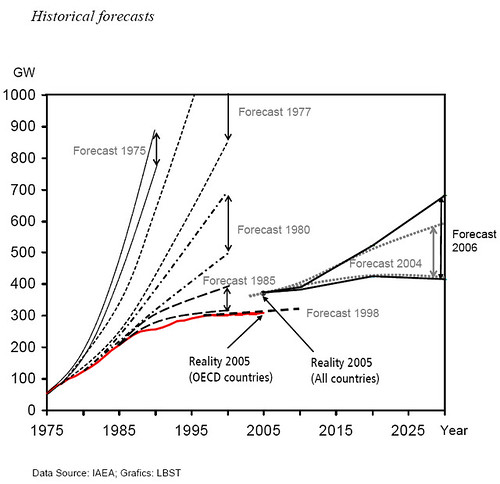They'll be "in construction" for a long time before they're canceled.
http://www.flickr.com/photos/16721844@N00/429450898/

Every two years the Nuclear Energy Agency (NEA) together with the International Atomic
Energy Agency (IAEA) publish detailed data about existing reactors, reactors under
construction, shut down reactors and also forecasts for the next 20�30 years. An early
forecasts in 1975 predicted the nuclear capacity of OECD member countries to grow to
between 772�890 GW by 1990. Based on such forecasts the uranium production capacities
were extended. But in reality, the installed capacity grew to 260 GW falling far below the
IAEA target range. The 1977 forecast was less ambitious, envisaging a range of between
860�999 GW by 2000. As the year 2000 came closer, the more modest the forecasts became
eventually predicting a capacity ranging between 318�395 GW by 2000. Actually, a total of
303 GW were installed in the year 2000. Every forecast by the IAEA in the past eventually
turned out as having been too optimistic.
http://www.csmonitor.com/Innovation/2009/0813/the-bumpy-road-to-nuclear-energy
In 1974, President Nixon announced Project Independence � a plan to build 1,000 nuclear stations. But of the 253 reactors eventually ordered by the US electric industry, 71 were canceled before construction began, according to a tally by the antinuclear group Beyond Nuclear.
Of the 182 construction permits granted by government commissions, 50 were abandoned in construction with billions in investment lost and 28 were closed before their 40-year licenses expired � including the Three Mile Island plant�s Unit 2.
Gary McCool knows all about the financial pitfalls of nuclear power. Thirty years ago the Plymouth State College reference librarian warned managers at his tiny New Hampshire Electric Cooperative that its plan to purchase 2 percent of the new Seabrook nuclear power plant�s generating output when it was completed could push the coop into bankruptcy � or perhaps produce the highest electric rates in the nation.
It turned out to be both. Today he�s still paying the price of nuclear power � even though his coop no longer purchases any. There on his monthly bill is a $6.06 charge for �stranded costs� � the cost of paying off the coop�s adventure into Seabrook.
It was a calamity echoed nationwide. Several government-owned power companies, including the Washington Public Power System, went bankrupt. Other investor-owned utilities, such as Long Island Lighting Company and Consumers Power, were nearly bankrupted.
This is a sidebar to the full story,
Nuclear power�s new debate: cost